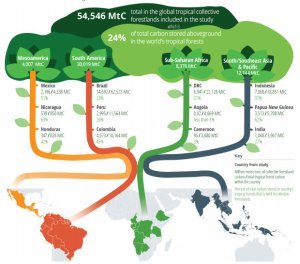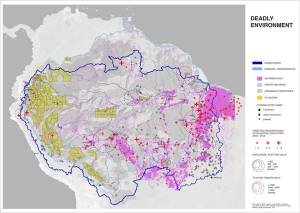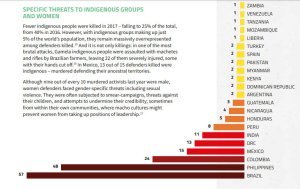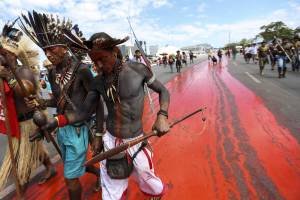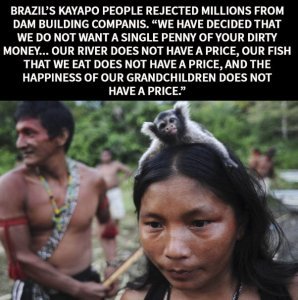The equivalent of 987,500 football fields of Amazon Rainforest have been destroyed over the last few years in Brazil
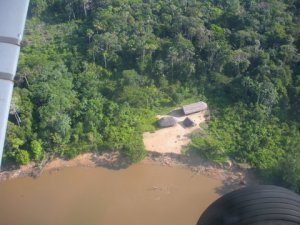
Isolated Amazon indigenous people. Photo taken by author.
60 million to 200 million indigenous people are almost wholly dependent on forests, these indigenous forest communities live in the world’s last remaining forests which are critically endangered as the equivalent of 987,500 football fields of Amazon Rainforest have been destroyed over the last few years in Brazil.
These indigenous forest communities are facing ecocide and they are key to the protection of the Amazon rainforest and climate balance. There are at least 80 indigenous tribes in the Amazon rainforest still living in complete isolation from the outside world. Human contact would be detrimental to their very existence, they are the most vulnerable communities since they have no resistance to disease and would be wiped out upon first contact with people from the outside world. We must respect their way of life and leave them in peace and protect them from gold and oil miners.
The Rights and Resources Initiative (RRI), Woods Hole Research Center (WHRC) and WRI Report found that Indigenous Peoples and local forest communities manage at least 54,546 million metric tons of carbon (Mt C) in the tropical forests they live in globally, or just under one-quarter of the total carbon found above ground in the global tropics.
Indigenous Peoples and local communities manage at least 24 percent of the total carbon stored aboveground in the world’s tropical forests, or 54,546 million metric tons of carbon (MtC), a sum greater than 250 times the amount of carbon dioxide emitted by global air travel.
There is a deeply intrinsic relationship between the health of the Amazon rainforest and the health of the planet. Rainforests contain 90-140 billion metric tons of carbon, not just in the tree trunks but also stored in the soil below, this helps stabilise local and global climate. Deforestation, oil extraction and mining activities releases significant amounts of this locked carbon, which is having catastrophic consequences on the climate around the world.
The Rights and Resources Initiative offers Amazon forest and global governments to consider improving protection of deforestation and forest degradation pressures, to enhance local livelihoods, tropical country governments and the international community should:
• Support the efforts of forest peoples’ organisations to document and secure their collective forest
rights by scaling up dedicated funding streams and technical assistance;
• Make Indigenous Peoples and local communities part of the climate solution by incorporating
community-based actions in Nationally Determined Contributions;
• Develop/adopt institutional safeguards that significantly increase the voice and contributions of forest peoples in the design and implementation priority actions to conserve/enhance forest carbon stocks and non-carbon benefits.
The Amazon rainforest is the worlds largest biodiversity rich biome containing more than half the worlds 10 million animal and plant species, with green capital preservation we can emphasize the immense value of the rainforest and its contribution to the planet.
The Amazon rainforest contains:
One in ten known species on Earth
1.4 billion acres of dense forests, half of the planet's remaining tropical forests.
4,100 miles of winding fresh water rivers.
2.6 million square miles in the Amazon basin, about 40 percent of South America.
We are at a critical time where global governments, rainforest conservation groups and non-governmental organisations need to reinforce protection of environmental laws for Indigenous people's defence treaties for the last remaining Amazon rainforests on the Earth. After spending fifteen years working on conservation projects with indigenous people in the Amazon, their challenges involve dealing with many front line issues that the largest established charities, governments and academic institutes know very little about. One common example in the Amazonia regions of South America, is the ongoing internalised governmental corruption where some government affiliated corporations provide finances and arms to military and vigilante groups to attack and continually persecute indigenous environmental activist leaders and to drive indigenous people forcefully off of their land. This is why there is an exponential rise of murders of Indigenous environmental activists every year.
One such story I learned in 2012 at Shell airport waiting to fly deep into the Amazon, here I met with Cristina Gualinga. Cristina is from the Kichwar Sarayaku territory in the Ecuadorian Amazon. The Sarayaku community were subject to violent force to remove them from their ancestral land by illegal invasion of oil companies and their government sponsored military soldiers. Cristina Gualinga and many in her Sarayaku community are life long activists against oil exploitation, after they were subject to brutal expulsion from their territory and Cristina witnessed systematic destruction of her ancestral lands for an oil pipeline, there is a documentary about the Sarayaku's experience called The Children of the Jaguar.
Governments who are included in the Amazon Basin region countries must collaborate with international conservation organisations and governments from all global countries to step up protection through reinforcement of environmental laws and indigenous peoples rights and powers to indigenous leaders of key communities who are our environmental protectors of the Amazon.
The international governments have a responsibility to the conservation of the planet and especially the Amazon rainforest and should be providing reinforced prosecution for indigenous communities threatened by oil extraction, hydrodam building or gold mining and every other activity that is rapidly causing ecocide in the Amazon rainforest.
The above map shows the amount of industrial activity in the Amazon and the red crosses show the amount of indigenous people assassinated due to conflicts over rainforest that they are fighting to protect.
Between August 2017 and July 2018 some 7,900 square kilometres of forest were logged in the Brazilian Amazon. In addition to the ongoing illegal logging and goldmines, in 2019 over 7,200 square miles of the Brazilian rainforest burned—an aggregated area nearly the size of New Jersey. The worst annual rate of deforestation in a decade, according to official government data. This represents an increase of 14 percent over the same period last year.
Greenpeace Brazil pointed out, approximately 1,185 million trees were felled in an area equivalent to the size of 987,500 football fields.
The above graph from Global Witness report ''At What Cost'' shows Brazil has the highest rate of environmental defenders being killed than any other country in the world.
Meanwhile, Jair Bolsonaro ignores invitations towards implementing and reinforcing conservation action by other Amazon countries and he encourages persecution of indigenous people, conveniently overlooking the continued murders of Amazon protectors and environmental campaigners, further accelerating the destruction of the Brazilian Amazon, last year many of the raging fires which raged through the Brazilian Amazon were a result of arson as a preliminary measure to clear forest for oil drilling and illegal gold mining in indigenous territories that should be protected areas of the Amazon. Bolsonaro has publicly declared his hatred of indigenous communities, specifically the Kawahivas people who are on the edge of extinction, his promise to corporate interests are to continue to open more the Amazon to the development of the mining and timber industries.
Global Witness's latest annual data into violence against land and environmental defenders shows a rise in the number of women and men killed over the last few years to 207 in Brazil especially. What’s more, Global Witness's research has highlighted agribusiness including coffee, palm oil and banana plantations as the industry most associated with these attacks.
Therefore, corporate sponsored murders of indigenous environmental protectors are conveniently overlooked, increasing the kidnappings, torture and assassination of key environmentalists. Consequently, illegal mining and logging activities are rising with corporate land grabs and violations of indigenous people’s rights to critical escalation Brazil and other countries that the Amazon basin covers, Ecuador, Peru and Colombia.
The Amazon rainforest is deadlier than ever for land and environmental defenders, with mining and oil industries and agribusiness, these industries are the most linked to the murder of environmentalists and indigenous rainforest activists.
Many indigenous communities live solely off of the land, many live in isolated regions that are difficult to access, they are adept at survival from the bounty of nature and in tune with the spiritual elements that come with their connection and close relationship with nature, therefore most of these communities are not in need of money or the materialistic way of living that Westerners are used to, and this goes in their favour to be the world’s best and most trusted conservationists. Their lives depend on the preservation and conservation of their ancestral land, not on money. Their connection with the environment is not just dependent on daily living, it is part of their spiritual ancestry, their spiritual ecology, part of their souls and beating hearts. This is what we have forgotten in Western civilisation.
For these reasons, Indigenous people are the best conservationists to manage and conserve the forests and last great wildernesses, as their immediate survival depends on the land and they are attuned to the environment around them, because of this, they are also the most vulnerable when it comes to ecocide, their cultures and survival is ultimately threatened. Read previous article People on the Edge of Extinction-The Last Tribes of the Amazon
There are indigenous conservation treaty recommendations supported by many Indian and Alaskan Native organisations. A recent convention set up by the Indigenous peoples of all the Americas allowed them to form sixteen principles for building a sustainable and harmonious world community.
These principles are rooted in the concerns of hundreds of Indigenous Elders, Spiritual Leaders and Community Members, they are also rooted in deep ecology values, they recognise the interconnection of all life on Earth and how we affect one another and the Earth with our actions. They recognise how humans must work on internal balance to create external balance and a sustainable world. They recognise the importance of morals, and ethics in communities. These guiding principles constitute the foundation for the process of healing and developing ourselves (mentally, emotionally, physically, and spiritually), our human relationships (personal, social, political, economic, and cultural) and our relationship with Mother Earth.
The senseless annihilation of the Earth’s last rainforests is part of an ecosystem, not only providing vital equilibrium for the climate but also plant medicines and foods and resources everyone takes for granted. Corporate ecocide has to stop along with the global unfolding ecocide of other ancient wildernesses where our great indigenous people remain.
All this senseless destruction of the Amazon rainforest, is for logging, gold, hydrodams and mostly for petroleum oil, the black life blood of Pacha Mama, Mother Earth, these resources are valued over human life and over the most essential biome of the Amazon rainforest, a major oxygen producer for all life on planet Earth. How many of us have to suffer and to what limit of destruction will this planet be pushed to, before we realise human consciousness is now an ecological issue? Humanity is a threat to itself unless we change the way we live on this planet, we have to live with nature, not separate from her, we are our environment, we are nature. Meanwhile there are solutions that we at Evolve to Ecology are working on to give more power and protection to indigenous communities in the Amazon with the Biobank Green Economy initiative.
by C S
Author of
Surviving Depression in a Depressing World, an Ecological Perspective
Carlita is an independent environmental journalist and project developer who provides information overlooked by mainstream journalism funded by political agendas, since Carlita has worked closely with indigenous groups in Latin America for the last fifteen years.
